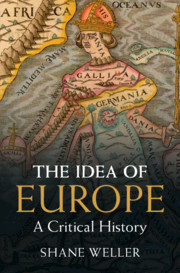Book contents
- The Idea of Europe
- The Idea of Europe
- Copyright page
- Contents
- Acknowledgments
- Introduction
- Chapter 1 Myths of Europa: From Classical Antiquity to the Enlightenment
- Chapter 2 A Great Republic of Cultivated Minds: 1712–1815
- Chapter 3 Nationalism and Universalism: 1815–1848
- Chapter 4 The Russia Question
- Chapter 5 Homo Europaeus: 1848–1918
- Chapter 6 The European Spirit: 1918–1933
- Chapter 7 A New European Order: 1933–1945
- Chapter 8 Unity in Diversity: 1945–1989
- Chapter 9 Other Europes
- Chapter 10 Europe against Itself: 1989 to the Present Day
- Conclusion Good Europeans?
- Notes
- Bibliography
- Index
Chapter 3 - Nationalism and Universalism: 1815–1848
Published online by Cambridge University Press: 14 May 2021
- The Idea of Europe
- The Idea of Europe
- Copyright page
- Contents
- Acknowledgments
- Introduction
- Chapter 1 Myths of Europa: From Classical Antiquity to the Enlightenment
- Chapter 2 A Great Republic of Cultivated Minds: 1712–1815
- Chapter 3 Nationalism and Universalism: 1815–1848
- Chapter 4 The Russia Question
- Chapter 5 Homo Europaeus: 1848–1918
- Chapter 6 The European Spirit: 1918–1933
- Chapter 7 A New European Order: 1933–1945
- Chapter 8 Unity in Diversity: 1945–1989
- Chapter 9 Other Europes
- Chapter 10 Europe against Itself: 1989 to the Present Day
- Conclusion Good Europeans?
- Notes
- Bibliography
- Index
Summary
If the eighteenth century was dominated by a French Enlightenment idea of Europe, following the French Revolution and then the Napoleon Wars, the early nineteenth century saw the rise of a German Romantic idea of Europe, dominated by strains of cultural nationalism. On the one hand, German Romantics such as Novalis looked back nostalgically to medieval Christendom for the model of a united Europe; on the other hand, thinkers such as Johann Gottlieb Fichte and the Schlegel brothers dreamed of a Europe dominated by German culture. The roots of the shift from universalism to nationalism lay in the work of writers such as Johann Gottfried Herder, who challenged French Enlightenment universalism with an insistence upon cultural differences. While Herder also challenged the prevailing Eurocentrism and Euro-universalism, the post-Napoleonic era saw both a growing nationalism across Europe and an intensifying European imperialism that would culminate in the “scramble for Africa” in the late nineteenth century. Chapter 3 explores the complex relation between the idea of Europe and that of nationalism in the Romantic period, focusing in particular on the ways in which the ostensibly antithetical ideas of the universal and the national were integrated into the idea of Europe.
Keywords
- Type
- Chapter
- Information
- The Idea of EuropeA Critical History, pp. 66 - 93Publisher: Cambridge University PressPrint publication year: 2021

